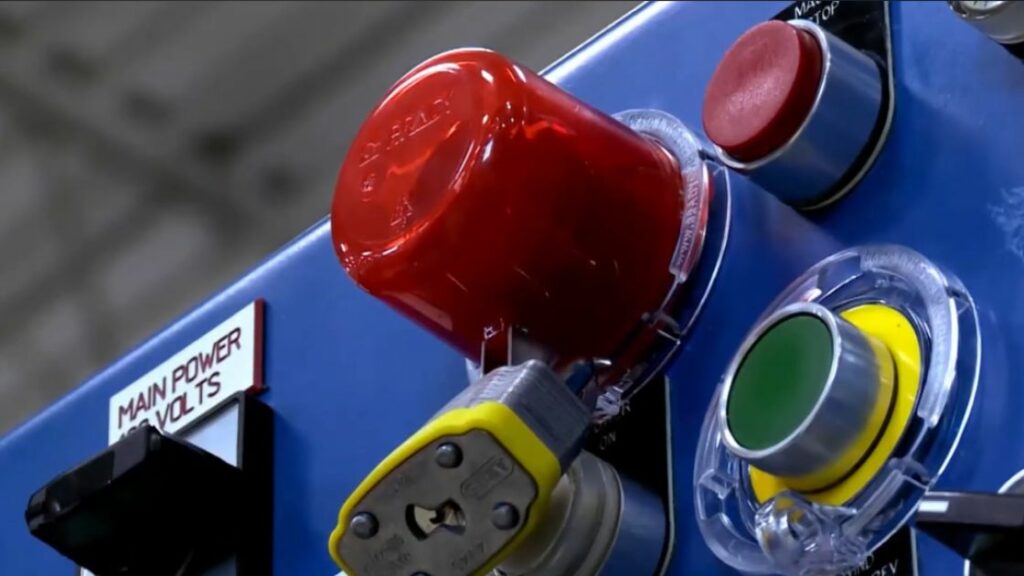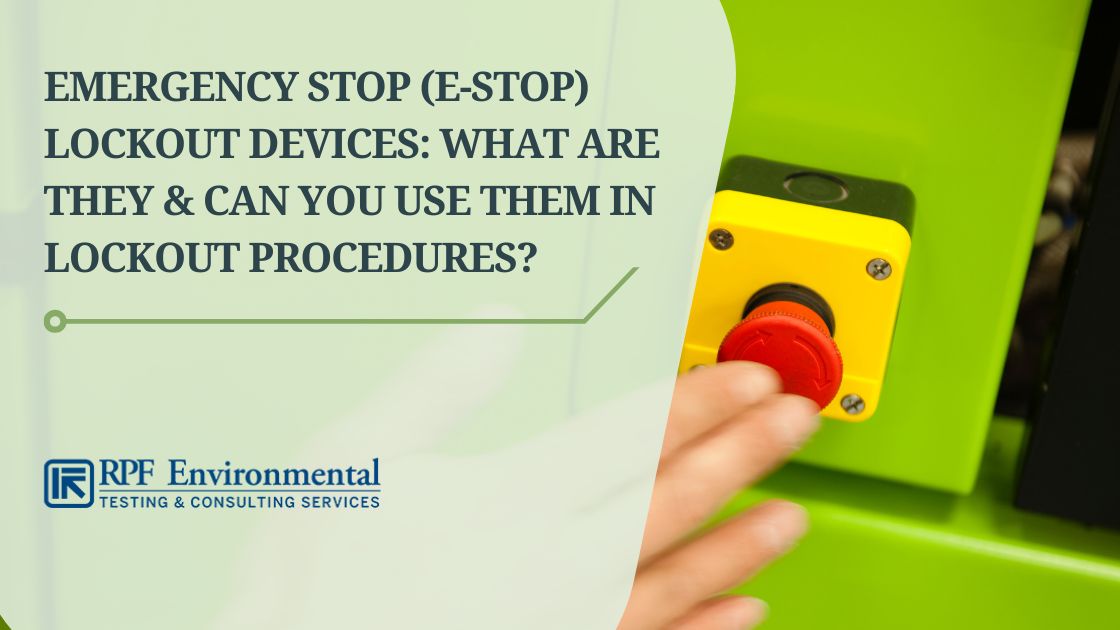NO. You can’t use emergency stop (E-Stop) devices in lockout procedures. You can prevent their unauthorized or accidental activation by using E-Stop lockout devices such as emergency stop safety covers. But, they do not meet OSHA’s definition of an energy-isolating device which employers are required to lock out before maintenance and servicing activities on machines involving hazardous energy. Thus, they won’t suffice for lockout procedures. Keep on reading for a more detailed explanation of why.

Learn more about proper lockout/tagout procedures through RPF Environmental’s professional environmental health and safety training courses in Maine, New Hampshire, Massachusetts, and other New England areas. Reach out to us now!
Definitions
Let’s start by defining what E-Stop devices and E Stop lockout devices are:
What Are E-Stop Devices?

Other Terms:
- Emergency Stop Push Button Switch
- Emergency Button
- Kill Switch
- Emergency Stop Switch
- E-Stop Switch
- Emergency Switch
- Emergency Push Button
- Push Button Safety Switch
- Safety Push Button Switch
Emergency stop devices are manually-operated and highly visible devices used to ensure the safety of workers and the machine itself without creating additional hazards. They are fail-safe control system devices manipulated by users to completely shut down equipment or a process. Thus, shutting off potential hazards to prevent further accidents from happening. They are common in industrial and commercial operations as well as in public facilities.
Types of Emergency Stop Devices
E-Stop push button devices are categorized into three common types:
- Push-Pull – Also called pull-release, this device is pushed in to activate it and reset by pulling it back to the original position
- Twist-Release – Also called turn-to-release, twist-release is also pushed in to lock it into position and reset by turning it to the indicated direction on the head of the button
- Key-Release – The same operation as the previous types but it is reset by unlocking with a key
How Do E-Stops Work?
Below is an overview of how emergency stops work:
- The operator presses the button to start the sequence.
- The equipment’s circuit is closed and the power supply is dcreatisconnected.
- The equipment stops functioning immediately.
NOTE: Emergency stop devices must follow rigorous standards and codes to ensure that they function as desired.
What Are Emergency Stop Lockout Covers?

Other Terms:
- Emergency Stop Safety Cover Lockout Device
- Emergency Switch Lockout Device
- Estop Lockout Cover
- Emergency Stop Button Cover Lockout
- Emergency Stop Push Button Cover Lockout
Emergency stop devices are sometimes installed with E-Stop lockout devices to guard them against unauthorized or accidental activation. E-Stop lockout devices often come in the form of push-button lockouts. They lock E-Stop devices in the off position by covering them entirely to prevent access. They also require a padlock to ensure that they won’t be removed easily.
Explaining Why E-Stop Lockout Devices Can’t Be Used in LOTO Procedures Based on OSHA’s Lockout/Tagout Standard

OSHA’s The Control of Hazardous Energy (Lockout/Tagout) standard contains the minimum requirements for controlling hazardous energy during machine/equipment maintenance and servicing. Among the important requirements is for employers to develop and implement lockout/tagout (LOTO) procedures in order to prevent fatalities and injuries in the workplace.
After defining what E-stop devices and lockout devices are, below are also OSHA’s definitions (section 1910.147(b) of the standard) in relation to a lockout procedure. We will use these definitions to explain why you can’t use E-Stop lockout devices alone in a LOTO procedure:
OSHA’s Definition of a Lockout
“The placement of a lockout device on an energy isolating device, in accordance with an established procedure, ensuring that the energy isolating device and the equipment being controlled cannot be operated until the lockout device is removed.”
OSHA’s Definition of a Lockout Device
“A device that utilizes a positive means such as a lock, either key or combination type, to hold an energy isolating device in a safe position and prevent the energizing of a machine or equipment. Included are blank flanges and bolted slip blinds.”
OSHA’s Definition of an Energy Isolating Device
“A mechanical device that physically prevents the transmission or release of energy, including but not limited to the following: A manually operated electrical circuit breaker; a disconnect switch; a manually operated switch by which the conductors of a circuit can be disconnected from all ungrounded supply conductors, and, in addition, no pole can be operated independently; a line valve; a block; and any similar device used to block or isolate energy. Push buttons, selector switches, and other control circuit type devices are NOT energy isolating devices.”
Based on the definitions above, lockout means placing a lockout device on an energy-isolating device. In addition, OSHA defined an energy-isolating device as something that physically prevents the transmission or release of energy. More importantly, it clarified that push buttons, selector switches, and other control circuit-type devices are NOT energy-isolating devices.
As defined previously, E-stop devices work by stopping the equipment’s control circuit. Thus, they are control system devices and are not considered energy-isolating devices by OSHA. This means that simply activating E-Stop push button switches won’t suffice for a lockout and you shouldn’t use them for this purpose. Although this is the case, you can use them as part of your lockout/tagout procedure as an additional layer of protection to isolate hazardous energy sources.
NOTE: The lockout/tagout procedure for different types of equipment will vary and will also depend on the needs of the workplace. OSHA has set minimum standards, but the employer should develop a detailed LOTO program that includes specific procedures that will be followed during a lockout/tagout. These procedures will also depend on local regulations in your area. You can read more on our blog about creating effective lockout/tagout procedures here.
Other Reasons Why Emergency Stops Are Not Effective for Controlling Hazardous Energy & Their Potential Impacts on Your Business
- Since they only stop the equipment from a single location, there is a possibility that the equipment will be accidentally restarted by other employees while maintenance is ongoing.
- The process of quickly halting the equipment can damage the machine and can create additional maintenance costs. This is why they are not used for production problems where safety is not involved.
- They require work if you want to restart the equipment which affects your business’s production.
Emergency Stop Requirements

E-Stops must meet machine and workplace safety standards required by the U.S. and international regulatory organizations. Some of the requirements are specified in the EN ISO 13850, EN/IEC 60204-1, NFPA 79, and OSHA standards.
E-Stops must:
- Be designed in such a way that activating them should quickly stop dangerous machine operations without creating additional hazards
- Have a bright red head and a yellow background
- Have a clear STOP print on them
- Stay running if not activated
- Be readily accessible and unobstructed with no actuation restrictions (the operator should norigort have to reach around, under, or over to actuate)
- Have a mushroom-head or palm-type actuator so it can be pushed easily
- Be self-latching (they shall remain in their actuated state once activated unless they are manually reset)
- Not resume operation or cause a restart when reset
- Be installed with a direct opening operation
- Shall be installed at every operator control station and other locations that require an E-Stop
- Remain unguarded
- Be enclosed or covered when used in specific environments to prevent unauthorized operation
- Be tamper-resistant and cannot be easily removed
- Not be used as replacements for automatic safety devices or machine safeguards and instead should be used as additional lines of defense
- Not impair other safety devices’ effectiveness
Aside from these key requirements, there are also industry-specific requirements that you should follow so make sure that you do your own research.
Other Things to Know About Emergency Stops

Are Emergency Stops Required?
Depending on the standard you are following, emergency stops may not be always required for machines. But, there are Canadian, US, and European regulations that require emergency stops if they can contribute to risk control and can benefit the user. (Unless there are product-specific standards requiring them.) Otherwise, you could consider alternatives in conjunction with risk assessments for situations that do not follow a risk assessment.
You should not also use E-Stops if they cannot effectively control risks or will just increase or create new risks. Simply put, not all machines require an E-Stop function.
Where Are Estops Required?
Emergency stops should be installed in locations where an operator is expected to be and those where machine tasks are done like consumable feeders and feed hoppers.
Also Read:
- Hazardous Waste Operations & Emergency Response: What is HAZWOPER?
- Occupational Hearing Loss (OHL): Everything You Need to Know
- Lockout vs Tagout: Difference Between Lockout and Tagout
- Everything You Need to Know About Confined Spaces
FAQs
No, you can’t use an E-Stop alone in your lockout procedures because they do not meet OSHA’s definition of a lockout/tagout. A LOTO procedure involves physically isolating hazardous energy sources which E-Stops don’t.
The main purpose of Estops is to provide a quick power disconnection to shut down the entire system or hazardous equipment in emergency situations where normal shutdown can’t be done. Thus, stopping the equipment immediately to reduce existing or avert arising hazards to workers and the equipment itself.
OSHA and other international standards require E-Stops to be readily accessible, unobstructed, self-latching, and remain unguarded. They must also be have a red mushroom head that is easy to push and a yellow background. You can read more in the Emergency Stop Requirements section of this blog.
Conclusion
Emergency stops are important components of an industrial equipment’s safety system because they provide a quick solution to stopping or controlling workplace accidents. However, they are not considered energy-isolating devices and won’t suffice for lockout procedures as per OSHA’s Lockout/Tagout standards. You can use them in addition to energy-isolating devices in your energy control procedures but not on their own.
Provide your employees with proper lockout/tagout training to ensure workplace safety through our environmental health and safety training courses in New England and across the United States. Reach out to us now!




